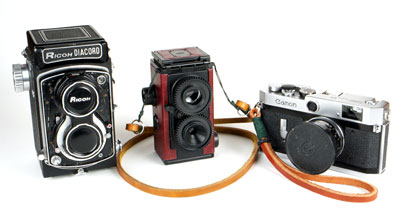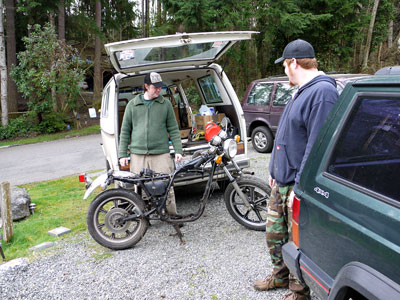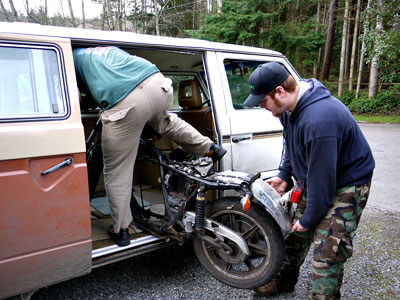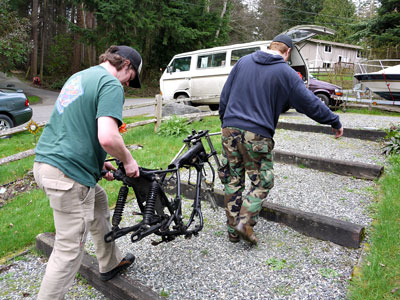

|
Archives
camera

 The little 35mm Gakkenflex TLR is between my 120 Ricoh Diacord and Canon P. The GakkenFlex came as a kit in a Japananese magazine. The magazine, Otona No Kagaku, means Science for adults and is published by Gakken. Each issue explores a subject with a kit you can make. Issue 25 was photography and the twin lens reflex with one you could build yourself. It's classified as a toy camera since it has a plastic lens with wonderful aberrations but it is incredibly well thought out. What makes this unique in toy cameras is that it can be focused just like it's big brother. It has one shutter speed and f stop which is around 1/150 sec at f11. It's a hoot! More here: Gakkenflex 35mm Twin Lens Reflex
economy "Whatever else one thinks of how we live these days, it's hard to not see it as temporary, historically anomalous, a peculiar blip in human experience. I've spent my whole life riding around in cars, never questioning whether the makings of tomorrow's supper would be there waiting on the supermarket shelves, never doubting when I entered a room that the lights would go on at the flick of a switch, never worrying about my personal safety. And now hardly a moment goes by when I don't feel tremors of massive change in these things, as though all life's comforts and structural certainties rested on a groaning fault line. "It had been one of those eventless weeks when the world pretended to be a settled place. The collapse of Greece seemed like little more than a passing case of geo-financial heartburn. The 36,000-odd newly-unemployed were spun magically into a feel-good story for public consumption, and the stock markets ratified it by levitating over a hundred points. The news media was preoccupied with the Great Question of whether the first woman film director would win a prize, thus settling all accounts in the age-old gender war, and the health care reform bill lumbered around the congressional offices like a zombie in search of a silver bullet that might send it back to the comforts of the tomb. "All in all, it was the sort of quiescent string of days that makes someone like me nervous. I can't help imagining what it was like in the spring of 1860, for instance, when so many terrible questions of polity hung over the country, and hundreds of thousands of young men still walked behind their plows or stood at their counting desks or turned their wrenches in the exciting new industries -- not knowing that destiny was busy preparing a ditch somewhere to receive their shattered corpses in places as-yet-unknown called Spotsylvania, Shiloh, and Cold Harbor. Or else my mind projects to the spring of 1939, when men dressed in neckties and hats sat in a ballpark watching Joe DiMaggio and Charlie Keller play "pepper" in the pregame sunshine, and nobody much thought about the coming beaches of Normandy and the canebrakes of the Solomon Islands. "Everything we know about it seems to indicate that human beings happily go along with the program -- whatever the program is -- until all of a sudden they can't, and then they don't. It's like the quote oft-repeated these days (because it's so apt for these times) by surly old Ernest Hemingway about how the man in a story went broke: slowly, and then all at once. In the background of last week's reassuring torpor, one ominous little signal flashed perhaps dimly in all that sunshine: the price of oil broke above $81-a-barrel. Of course in that range it becomes impossible for the staggering monster of our so-called "consumer" economy to enter the much-wished-for nirvana of "recovery" -- where the orgies of spending on houses and cars and electronic entertainment machines will resume like the force of nature it is presumed to be. Over $80-a-barrel and we're in the zone where what's left of this economy cracks and crumbles a little bit more each day, lurching forward to that moment when something life-changing occurs all at once."
rockets
We should remember that our space program started in the slave labor camp Dora during WWII. At the end of the war we spirited away the German scientists and rockets to the US to begin our space program.
Dora and the V-2 "Welcome! This website provides information for an exhibit at the UAHuntsville Salmon Library from February 21-March 12, 2010 entitled Dora and the V–2: Slave Labor in the Space Age. Both the site and the exhibit explore the history of forced labor in the construction of the V–2 missiles at the Dora concentration camp and Mittelwerk underground factory near Nordhausen, Germany, during World War II. "The stories center on the victims of Dora, the prisoners from many nations who were forced to work in the camp and its sub-camps and in the underground factory assembling the V–2. Usually, especially in Huntsville, Alabama, the V–2 is remembered through the engineers who designed it, rather than the forced laborers who put it together. Yet the prisoners died by the score or lived through dehumanizing cruelty, and their experiences deserve to be remembered."

race
The New Jim Crow "Ever since Barack Obama lifted his right hand and took his oath of office, pledging to serve the United States as its 44th president, ordinary people and their leaders around the globe have been celebrating our nation’s “triumph over race.” Obama’s election has been touted as the final nail in the coffin of Jim Crow, the bookend placed on the history of racial caste in America. "Obama’s mere presence in the Oval Office is offered as proof that “the land of the free” has finally made good on its promise of equality. There’s an implicit yet undeniable message embedded in his appearance on the world stage: this is what freedom looks like; this is what democracy can do for you. If you are poor, marginalized, or relegated to an inferior caste, there is hope for you. Trust us. Trust our rules, laws, customs, and wars. You, too, can get to the promised land. "Perhaps greater lies have been told in the past century, but they can be counted on one hand. Racial caste is alive and well in America. "Most people don’t like it when I say this. It makes them angry. In the “era of colorblindness” there’s a nearly fanatical desire to cling to the myth that we as a nation have “moved beyond” race. Here are a few facts that run counter to that triumphant racial narrative: "*There are more African Americans under correctional control today -- in prison or jail, on probation or parole -- than were enslaved in 1850, a decade before the Civil War began. "*As of 2004, more African American men were disenfranchised (due to felon disenfranchisement laws) than in 1870, the year the Fifteenth Amendment was ratified, prohibiting laws that explicitly deny the right to vote on the basis of race. "* A black child born today is less likely to be raised by both parents than a black child born during slavery. The recent disintegration of the African American family is due in large part to the mass imprisonment of black fathers. "*If you take into account prisoners, a large majority of African American men in some urban areas have been labeled felons for life. (In the Chicago area, the figure is nearly 80%.) These men are part of a growing undercaste -- not class, caste -- permanently relegated, by law, to a second-class status. They can be denied the right to vote, automatically excluded from juries, and legally discriminated against in employment, housing, access to education, and public benefits, much as their grandparents and great-grandparents were during the Jim Crow era."
photography "We live in a small town in the agricultural plains of western Taiwan. My husband, Michael, and I moved here four months ago for a number of reasons; but most pivotally, I had made a relationship with the Chinese-speaking world that two years of previous living, working and traveling in mainland China did not suffice as enough. You too have a special place that awakened you in someway (I’d wage a bet). In the practice of photography, our ‘place’ is one of our most potent ingredients, right up there with the presence of light. Our place inspires and/or frazzles us to point a camera at it. I was inspired and frazzled by China via the undeviating attention and persistence it required of me. Admittedly and naively, I suspected that my China familiarity had trained me for whatever the island of Taiwan has to offer. But in truth, the assumption that I’m ever culturally equipped to photograph anywhere I land is sorely naive, and I try to check myself periodically. Photographing under this delusion is perhaps like fishing using a broad net with wide holes. You’ll definitely catch something impressive at some point, but there are the unfortunate dolphins, and all the smaller tasty ones that will slip back into the dark oblivion."

republican party -- the party of the sociopath Tom Delay: People Are Unemployed Because They Want To Be
"Former House Majority Leader Tom Delay called Sen. Jim Bunning (R-Ky.) "brave" on Sunday for launching a one-man filibuster of unemployment benefits, arguing that they dissuaded people from going out and finding work. "You know," Delay said, "there is an argument to be made that these extensions, the unemployment benefits keeps people from going and finding jobs. In fact there are some studies that have been done that show people stay on unemployment compensation and they don't look for a job until two or three weeks before they know the benefits are going to run out."
Ayn Rand, Hugely Popular Author and Inspiration to Right-Wing Leaders, Was a Big Admirer of Serial Killer "There's something deeply unsettling about living in a country where millions of people froth at the mouth at the idea of giving health care to the tens of millions of Americans who don't have it, or who take pleasure at the thought of privatizing and slashing bedrock social programs like Social Security or Medicare. It might not be so hard to stomach if other Western countries also had a large, vocal chunk of the population that thought like this, but the U.S. is seemingly the only place where right-wing elites can openly share their distaste for the working poor. Where do they find their philosophical justification for this kind of attitude? "It turns out, you can trace much of this thinking back to Ayn Rand, a popular cult-philosopher who exerts a huge influence over much of the right-wing and libertarian crowd, but whose influence is only starting to spread out of the U.S. "One reason most countries don't find the time to embrace Ayn Rand's thinking is that she is a textbook sociopath. In her notebooks Ayn Rand worshiped a notorious serial murderer-dismemberer, and used this killer as an early model for the type of "ideal man" she promoted in her more famous books. These ideas were later picked up on and put into play by major right-wing figures of the past half decade, including the key architects of America's most recent economic catastrophe -- former Fed Chair Alan Greenspan and SEC Commissioner Chris Cox -- along with other notable right-wing Republicans such as Supreme Court Justice Clarence Thomas, Rush Limbaugh and South Carolina Gov. Mark Sanford. "The loudest of all the Republicans, right-wing attack-dog pundits and the Teabagger mobs fighting to kill health care reform and eviscerate "entitlement programs" increasingly hold up Ayn Rand as their guru. Sales of her books have soared in the past couple of years; one poll ranked Atlas Shrugged as the second most influential book of the 20th century, after the Bible. "The best way to get to the bottom of Ayn Rand's beliefs is to take a look at how she developed the superhero of her novel, Atlas Shrugged, John Galt. Back in the late 1920s, as Ayn Rand was working out her philosophy, she became enthralled by a real-life American serial killer, William Edward Hickman, whose gruesome, sadistic dismemberment of 12-year-old girl named Marion Parker in 1927 shocked the nation. Rand filled her early notebooks with worshipful praise of Hickman. According to biographer Jennifer Burns, author of Goddess of the Market, Rand was so smitten with Hickman that she modeled her first literary creation -- Danny Renahan, the protagonist of her unfinished first novel, The Little Street -- on him. "What did Rand admire so much about Hickman? His sociopathic qualities: "Other people do not exist for him, and he does not see why they should," she wrote, gushing that Hickman had "no regard whatsoever for all that society holds sacred, and with a consciousness all his own. He has the true, innate psychology of a Superman. He can never realize and feel 'other people.'" "This echoes almost word for word Rand's later description of her character Howard Roark, the hero of her novel The Fountainhead: "He was born without the ability to consider others." (The Fountainhead is Supreme Court Justice Clarence Thomas' favorite book -- he even requires his clerks to read it.)"
pinhole
April 25 will be World Pinhole Camera Day. Participate in style with these beautiful paper model pinhole cameras. "Take a break from your computer! Download, print and build your own pinhole camera. Follow the instructions and enjoy!"

afghanistan "As journalist Gareth Porter said in a recent interview with Real News, Gen. Stanley McChrystal’s offensive in Marjah, Afghanistan, is "more of an effort to shape public opinion in the United States than to shape the politics of the future of Afghanistan." Like so much of what we’ve seen in our woeful war on terrorism, the Marjah effort is short on substance and long on Newspeak, Doublethink, and other Orwellian deceptions."
The Battle for Marjah "The fighting is still underway in the town of Marjah, in what is being described as the first battle in Obama’s War in Afghanistan, or alternatively as the biggest battle of the US War in Afghanistan. But already, the US has lost that battle. "It lost it from day one, when troops fired missiles in to a Marjah house, killing 12 civilian occupants--half of them children. And it lost it further when another three more civilians were blown away by US-led forces. Finally, it lost the battle as much of the town has been simply destroyed by the fighting. "The supposed goal of the assault on Marjah was to demonstrate that the US would bring the wonders of good government and peace to the Pashtun tribal people who have endured a generation or more of war, and who have been living under the “cruel tyranny” of the Taliban in recent years. The new strategy of President Barack Obama and his hand-picked military leader in Afghanistan, Gen. Stanley McChrystal, was to show that the US military could fight the Taliban without causing civilian deaths and casualties. Protecting civilian lives would be a priority, they claimed. "The problem with such a strategy is that the whole reason American forces have been able to crush resistance, as they did in the lighting invasion of Iraq in 2003, or the overthrow of the Taliban government of Afghanistan in late 2001, has been their callous disregard for civilian lives, which have been coldly labelled “collateral damage.” "
Explain Something to Me "So explain something to me: Why does the military of a country convinced it's becoming ungovernable think itself so capable of making another ungovernable country governable? What’s the military’s skill set here? What lore, what body of political knowledge, are they drawing on? Who do they think they represent, the Philadelphia of 1776 or the Washington of 2010, and if the latter, why should Americans be considered the globe’s leading experts in good government anymore? And while we’re at it, fill me in on one other thing: Just what has convinced American officials in Afghanistan and the nation’s capital that they have the special ability to teach, prod, wheedle, bribe, or force Afghans to embark on good governance in their country if we can’t do it in Washington or Sacramento? "Explain something else to me: Why are our military and civilian leaders so confident that, after nine years of occupying the world’s leading narco-state, nine years of reconstruction boondoggles and military failure, they suddenly have the key, the formula, to solve the Afghan mess? Why do leading officials suddenly believe they can make Afghan President Hamid Karzai into “a Winston Churchill who can rally his people,” as one unnamed official told Matthew Rosenberg and Peter Spiegel of the Wall Street Journal -- and all of this only months after Karzai, returned to office in a wildly fraudulent presidential election, overseeing a government riddled with corruption and drug money, and honeycombed with warlords sporting derelict reputations, was considered a discredited figure in Washington? And why do they think they can turn a man known mockingly as the “mayor” or “president” of Kabul (because his government has so little influence outside the capital) into a political force in southern Afghanistan? "And someone tell me: Just who picked the name Operation Moshtarak for the campaign in Marja? Why am I not convinced that it was an Afghan? Though news accounts say that the word means “togetherness” in Dari, why do I think that a better translation might be “crushing embrace”? What could “togetherness” really mean when, according to the Wall Street Journal, to make the final decision to launch the operation, already long announced, General McChrystal “stepped into his armored car for the short drive... to the presidential palace,” and reportedly roused President Karzai from a nap for “a novel moment.” Karzai agreed, of course, supposedly adding, “No one has ever asked me to decide before.” "
Totally Occupied: 700 Military Bases Spread Across Afghanistan "In the nineteenth century, it was a fort used by British forces. In the twentieth century, Soviet troops moved into the crumbling facilities. In December 2009, at this site in the Shinwar district of Afghanistan’s Nangarhar Province, U.S. troops joined members of the Afghan National Army in preparing the way for the next round of foreign occupation. On its grounds, a new military base is expected to rise, one of hundreds of camps and outposts scattered across the country."
'Government in a box' in Marja "What you see depends on where you sit. My seat at present is in Marfa, a small town in rural West Texas. Yet Marfa turns out to be an oddly instructive vantage point from which to contemplate the latest developments in far-off Afghanistan. "On Saturday, U.S. Marines and other coalition troops launched the largest allied offensive since Operation Enduring Freedom began nearly nine years ago. The target of that assault is Marja, a mostly Pashtun city in the heart of Helmand province. The senior Marine commander on the ground promised "to go in big, strong and fast." "In fact, the operation is proceeding with notable deliberation. Yet what matters in Marja is not the fight itself -- in that regard, the coalition's superior forces mean the outcome is foreordained -- but what comes next. "The purpose of Operation Moshtarak (Dari for "together") is to clear the Taliban from the city and then to fix the place, winning the hearts and minds of the local population. Toward that end, said Army Gen. Stanley A. McChrystal, the commander of Western forces in Afghanistan, "We've got a government in a box, ready to roll in." As government arrives on the coattails of the Marines, it will ensure law and order, set up schools and clinics, repair roads, revitalize the irrigation system and cajole farmers into cultivating something other than opium poppies. The successful transformation of Marja will demonstrate the viability of McChrystal's plan to transform Afghanistan as a whole. At least that's the idea. "The United States tried once before to transform Marja and its environs. An ambitious agricultural reform program sponsored by the U.S. Agency for International Development in the 1950s proved a total flop in terms of lasting changes. "What presumably promises to produce a different outcome this time around -- the factor that will make change stick -- is the direct involvement of the United States military. The unstated assumption: The sustained presence of U.S. troops implies real and lasting results. What worked in Germany and Japan after 1945 ought to work in Afghanistan today." PART THREE - THE LOST HISTORY OF HELMAND "When you look at footage of the fighting in Helmand today everyone assumes it is being played out against an ancient background of villages and fields built over the centuries. "This is not true. If you look beyond the soldiers, and into the distance, what you are really seeing are the ruins of one of the biggest technological projects the United States has ever undertaken. Its aim was to use science to try and change the course of history and produce a modern utopia in Afghanistan. The city of Lashkar Gah was built by the Americans as a model planned city, and the hundreds of miles of canals that the Taliban now hide in were constructed by the same company that built the San Francisco Bay Bridge and Cape Canaveral."
polaroid
 Picture This: The Impossible Project That Kept Polaroid Film Alive "Judging by the way Polaroid distances itself from the Impossible Project, you might never realize that the small Dutch film maker saved Polaroid and its beloved instant photographs from extinction. "Polaroid, which suffered badly since the death of its inventive founder Edwin Land in 1991, could have completely lost the instant film -- a whole artistic medium, pop culture icon and technological marvel in one -- had the company not crossed paths with the Impossible Project's founder, Florian Kaps, a man described as a "crazy Austrian entrepreneur." "Kaps sought to do what seemed impossible -- rally a group of disgruntled factory workers to re-invent a nearly destroyed technology and bring Polaroid's instant film business back from the grave. To this end, Kaps and his Impossible Project have been improbably successful. "Yet, Polaroid doesn't seem to appreciate how impossibly lucky it has been."
 I await the results of this project with my SX70.
insanity How insane are the leaders of this country? Gates: European Aversion to War a Danger to Peace Speaking today at the National Defense University, US Secretary of Defense Robert Gates condemned European nations in general for their refusal to contribute larger portions of their population to NATO. Gates warned that Europe’s aversion to war was doing serious harm to assorted US military operations with NATO backing, and was therefore “an impediment” to the lasting peace he envisions those wars eventually creating.
projects This is an unfinished project passed on from father to son.


 This is a project I've been dragging around for years. I've wanted to make a 500 single cafe racer based on the Yamaha SR 500. I bought my first SR500 in 1983. I commuted on it in LA for a couple of years and when we returned to Puget Sound and moved to Whidbey Island I ended up with a second SR500 for another couple of years of commuting. Both SR500s were not ridable but I had hopes of combining them into one good bike. I've reached the point that all the projects I have aren't going to get done in my lifetime and this one was getting in the way of another project so my son Robby, with the help of his cousin Adam, are going to give it a shot. I wish them the best of luck.
The other project that the bikes were getting in the way of is a darkroom. I have a 6 foot stainless sink and a bunch of 3 1/2 gallon stainless tanks for developing film coming by the end of the month. I have no interest, actually I have less than no interest, in setting up an darkroom for printing but a black and white film line would be most useful. 3 1/2 gallon tanks are big enough to develop 8x10 film. This will be handy since, along with the sink and tanks, I will be getting an 8x10 view camera with studio stand. The 8x10 comes with a large brass soft focus lens. I'm getting them from a photographer that I do occasional printing for. They are projects that he realizes he isn't going to get done in his lifetime. He will be back from a trip later this month and will then haul them out of his storage. Stay tuned.
|
|